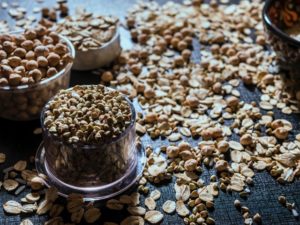February is American Heart Month. Someone in the United States has a heart attack every 40 seconds, and strokes effect hundreds of thousands of people every year. You can reduce your risk of heart attack and stroke with some simple changes to your lifestyle. Older people are not the only ones at risk. People in their twenties and thirties can also develop heart disease. It’s never too late or too early to improve your heart health.
Here are five lifestyle changes you can make this month:

1. Eat the Right Types of Carbs
You’ve probably heard that you should avoid trans fats and cut back on saturated fats, but fat is not the only food group that can harm your heart. Sugar has also been shown to have a detrimental effect on heart and vein health.
The American Heart Association recommends that men consume less than 36 grams of sugar per day and women less than 24 grams. Added sugars, those that are not naturally found in whole foods, are listed on product packaging. Anything that ends in -ose, such as sucrose, dextrose, and maltose, are types of sugar. Brown sugar, coconut sugar, and agave syrup are not healthier alternatives. As far as your body is concerned, sugar is sugar.
Eating too much added sugar could lead to fatty liver, diabetes, high blood pressure, and chronic inflammation. All of these conditions put a strain on your heart and other organs.
Processed carbohydrates like white flour are converted into sugar very quickly after you consume them. They have virtually the same effect on your body as added sugars do. It is recommended that you switch out most of your white flour products for products made from whole grains. Whole grains include whole wheat, oats, quinoa, brown rice, buckwheat, and millet.
It is now easier than ever to find products made from whole grains on your grocery store shelves. You don’t have to sacrifice convenience or flavor. Several brands of boxed mac-and-cheese style pasta use whole grains, and you can even find whole-wheat graham cracker cookies. Simple switches like these can help you get more nutrients and less sugar.

2. Pay Attention to both Calories and Nutrients
Another good reason to cut back on sugar and processed carbs is to lower your overall calorie intake. To figure out how many calories you need a day, use an online calorie calculator. These will ask you about your height, weight, age, and activity level and then do the math for you. If you are sedentary, you probably don’t have much room in your diet for extras. Figuring out how many calories you usually eat and comparing that with how many you need can help determine what kinds of changes you need to make in your diet.
Remember that calories are not the whole picture. Nutrients are also essential. Technically a person could eat nothing but processed snack foods and stay within their recommended calorie intake, but they would become undernourished. Meeting your calorie needs with whole foods like fruits, vegetables, whole grains, legumes, and grass-fed meat will give you the nutrients you need to be healthy.
Fruits, veggies, beans, and whole grains contain fiber. Eating enough fiber every day not only helps to prevent constipation, it also can help you lose weight and lower your cholesterol. Men should aim for 30 to 38 grams of fiber per day and women for 20 to 25 grams. Increase your intake slowly to prevent stomach cramps and bloating.
If you have trouble getting enough fiber in your diet, you can take a supplement. Psyllium husk fiber is beneficial for lowering cholesterol and assisting with weight loss. The best way to get fiber is through foods you eat, so don’t use fiber supplements to substitute for a healthy diet.

3. Increase Your Activity
Exercise is important for maintaining a healthy weight and for strengthening your heart and lungs. There are two types of exercise, strength training, and aerobics. Some exercise routines combine both.
Strength training focuses on building muscle and is useful for losing weight and building strength. Aerobic exercise works your heart and lungs. Over time, aerobic activity makes your heart more efficient, so it doesn’t have to work as hard to do its job. It also helps your body circulate oxygen into your bloodstream easier. The result is more energy and stamina, as well as improved heart and lung health.
Many Americans struggle to find the time to work out. Here’s the good news: you don’t have to spend hours at the gym every day to get the exercise you need. 150 minutes of moderate level activity every week can help you maintain a healthy weight. That breaks down to 21 minutes a day, about the length of a sitcom. Not too bad, right?
Start out aiming for around twenty minutes a day of an exercise that matches your fitness level. This could be a power walk around your neighborhood or a fitness routine on YouTube. Don’t forget that walking your kids to school, carrying groceries up your stairs, and other daily activities can count towards your exercise goal.
Of course, 20 minutes a day is the minimum amount of exercise needed to maintain health and an already healthy weight. Improving your heart health or losing some extra pounds will require more activity. Start with the 20 minutes, then add five or ten minutes to that until you are up to your goal.
Thirty minutes of moderate activity followed by at least ten minutes of vigorous aerobic exercise is a good goal for many people. To find out what sort of exercise routine would be best for you, talk to your doctor or a licensed fitness trainer.

4. Balance Your Fats
Fat used to have a bad reputation, but now we know that some fats are good for you. Omega-3 fats, in particular, are useful for improving heart health. They lower cholesterol, decrease inflammation and have a mild blood-thinning effect. Omega-6 fats are also healthy, but the balance between these two types of fats is essential.
A healthy ratio of Omega-6 to Omega-3 fats is between 1:1 and 4:1. The ratios in a typical western diet are more like 15:1. Studies have found that this imbalance promotes inflammation, which in turn harms heart health. Omega-6 fats are found in seed and plant oils such as soybean, cottonseed, corn, and sunflower oils.
If you check the ingredient list on your favorite packaged food items, you’ll find these types of oils. They are not bad in themselves, but most Americans don’t eat enough foods rich in Omega-3s to correct the balance. These include fish and fish products like cod liver oil, flaxseeds, walnuts, and Chia seeds.
In addition to cutting back on foods that contain large amounts of Omega-6 fatty acids and increasing your intake of omega-3 rich foods, you can also take a fish oil supplement. This is an easy way to significantly up your intake of omega-3s. Fish oil supplements have been proven to help fight inflammation and lower cholesterol. They are especially helpful for people who don’t love eating fish.
A healthy heart is essential to a healthy life. Making even one healthy change to your lifestyle this month can go a long way towards improving your heart health in the future.

